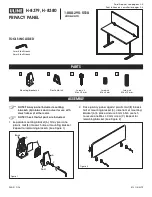
- 6 -
CHANGING THE HAMMER (see Fig. 9)
BEFORE STARTING ANY SERVICING WORK DISCONNECT THE ELECTRICAL SUPPLY
The hammer is the part which drives the wedges through the distributor head (Fig. 5)
Procedure
Slide the cross bar until it is approximately 10cm.(4") from the front of
the machine.
Remove the plastic bung (0) by pulling down.
Remove the side panels to gain access to the interior.
Above the vertical cylinder is the lower horizontal bar (Fig. 9)
Release the screws holding the microswitch (P)
Remove the microswitch ( P ) , sliding the assembly towards the left and then
pulling towards you.
To avoid any maladjustment do not remove the microswitch from its mounting point.
Slacken the Allen screw holding the fixed stop in position.
Hold the vertical cylinder and lift it slightly so that the fixed stop can be
turned through 90°.
Lower the cylinder and hammer assembly until the cross bar touches the worktable.
Undo the screw holding the hammer.
Remove the hammer to be changed.
Grease the new hammer and fit carefully into place.
Insert the locating pin and the hammer holding screw into the hole and tighten the
screw sufficiently until the hammer is held against its support.
Raise the cylinder and hammer assembly so that the fixed stop can be turned back
through 90° to support it.
Replace the microswitch (P) and tighten the fixing bolts.
N.B. The hammer is the delicate part of the machine. You
can
avoid breakages
by following certain rules.
Use hardwood wedges when joining certain timbers such as Ramin or Oak.
If the bung is maladjusted (see page 3 ) , or if there is blockage, or the
wedge has difficulty in penetrating because the wrong wedges have been chosen,
the machine will stop and the "incident" indicator will illuminate.
In order to start the machine again check the reason for the breakdown (see
page 8) and just press the key RAZ.





























